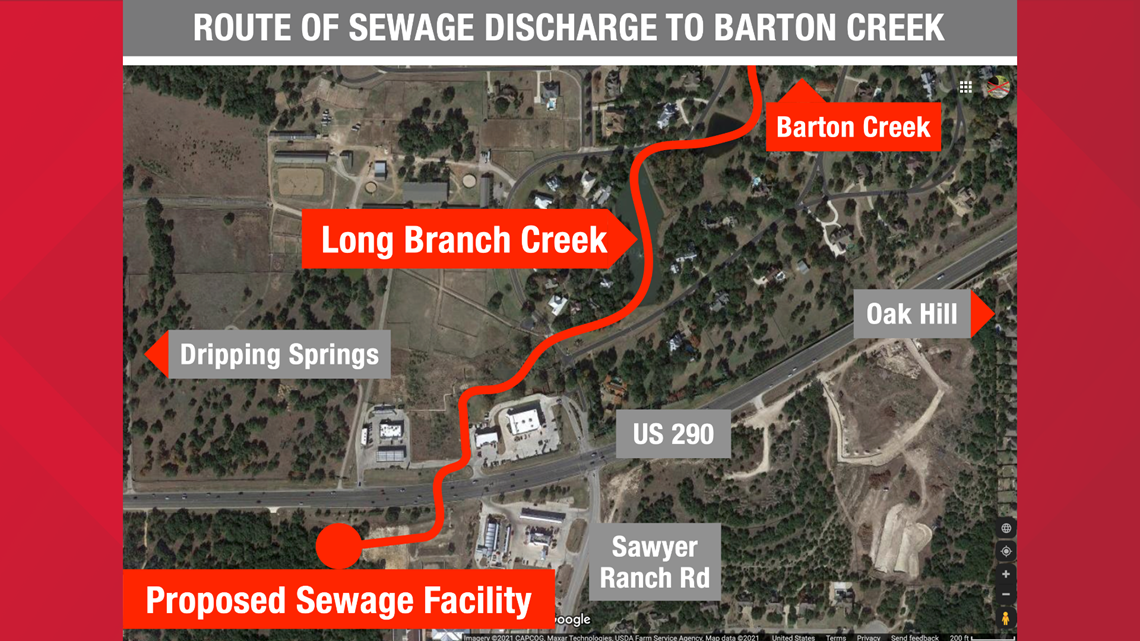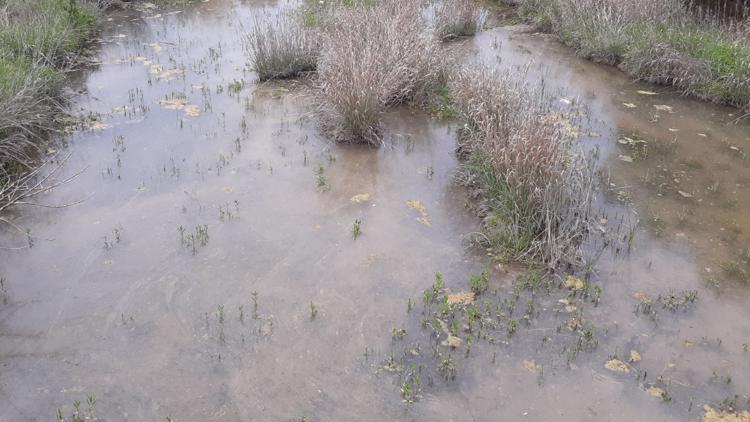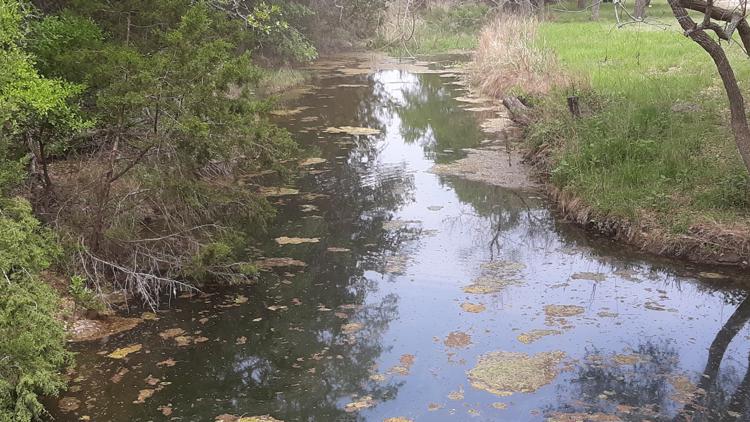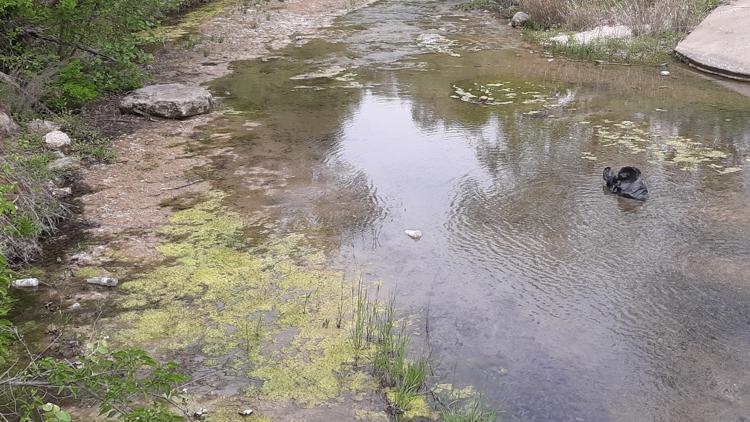AUSTIN, Texas — A Houston-based developer has withdrawn a permit application for a planned sewage treatment facility on Barton Creek after facing intense opposition at a public meeting on Tuesday held by the Texas Commission on Environmental Quality (TCEQ).
A local group spoke out against the proposed sewage facility near Barton Creek, claiming it could have eventually clog the beloved stream with algae.
According to the Save Barton Creek Association, the facility would have been located between Oak Hill and Dripping Springs. They said it could have dumped up to 45,000 gallons of treated wastewater into one of Barton Creek's contributing streams every day. Citing a City of Austin study, the group claimed the pollutants remaining in that treated sewage could have caused algae growth for several miles along the Long Branch tributary of the creek.
"Algae is getting out of control in a lot of hill country streams because of sewage discharge,” said Brian Zabcik, wastewater campaign organizer, Save Barton Creek Association.
This issue of treated wastewater being discharged into our waterways is something the KVUE Defenders have covered extensively for years.
Thousands of businesses and cities have permits to discharge treated wastewater into our rivers, lakes and streams. All apply for permits through the TCEQ.
Those permits contain a volume limit (the maximum number of gallons of treated sewage that can be released each day), as well as pollutant limits. These limits specify the amount of each pollutant that can remain in treated sewage, since the treatment process doesn’t remove all of the pollutants.
Treated sewage contains high amounts of nitrogen and phosphorus, the substances used in all lawn and garden fertilizers. When excess amounts of nitrogen and phosphorus flow into streams and lakes, they can fertilize the growth of algae. Several Central Texas streams have been plagued by large algae blooms below sewage plants, including the South San Gabriel River below Liberty Hill and the Blanco River below the City of Blanco.
TCEQ issued a draft sewage discharge permit last month to the Houston-based developer Stephen Cleveland. Cleveland told the KVUE Defenders he has been selling commercial lots from land his family owns on the southwest corner of US 290 and Sawyer Ranch Road and this is the last section he wants to sell.


The TCEQ held its only planned public meeting online at 7 p.m. on Tuesday (ID number: 189-821-291). According to the Save Barton Creek Association, Cleveland's decision to withdraw his proposal represents one of the very few times TCEQ hasn't approved an application for a sewage discharge permit after receiving it.
"This was a rare win in our fight against sewage pollution," said Zabcik. "SBCA has been organizing community opposition to the proposed sewage facility since 2017, when Cleveland filed his permit application."
At Tuesday's TCEQ public meeting, several landowners who live along Long Branch spoke out against the permit.
“There doesn’t have to be a winner and a loser here,” said Beth McConnell, a homeowner in the Polo Club subdivision, located half a mile downstream of the proposed sewage facility. “Every other business around here does the right thing with onsite septic systems. Cleveland can too.”
"We want to thank everyone who's been involved in this fight," said Clark Hancock, SBCA's board president. "We especially want to thank Mr. Cleveland and his family for recognizing the importance of protecting water quality in the Barton Creek basin."
In a Wednesday email to TCEQ, Cleveland wrote: "After hearing all the impassioned people in the meeting last night, our family has decided to ask that our application be withdrawn."
"We are extremely pleased that the Cleveland family listened to the community’s concerns and opted for a no-discharge alternative," said Kelly Davis, staff attorney with Save Our Springs Alliance. "However, there's still much to be done in the bigger fight to keep our fragile Hill Country streams clean and clear for all to enjoy."
It is rare for a private developer to get this kind of permit. Typically, these are given to cities and municipalities.
According to the Save Barton Creek Association, the four businesses already built on Cleveland's lots use onsite septic systems to dispose of their wastewater. However, they say he applied for a sewage discharge permit for one of his unsold lots in 2017.
“Should one person have the right to dump waste into a creek at the expense of the many landowners and creek visitors downstream? We don't think so," said Angela Richter, executive director of Save Barton Creek Association. “The Hill Country Sewage Scorecard, which SBCA released last fall, found that 81% of all municipal sewage discharge plants in our region exceeded at least one of their permit limits since 2017. The odds are good that Cleveland’s facility would follow this pattern too.”
Residents claim the sewage from Cleveland's proposed facility would have gone through residential developments lining both sides of Long Branch Creek for about seven miles. This tributary then joins Barton Creek to flow through Shield Ranch, a protected natural area.
PHOTOS: Group protesting planned sewage facility near Barton Creek
The group reports that treated sewage can contain high amounts of nitrogen and phosphorous, which can fertilize the growth of algae. And although Cleveland's draft permit included limits for both, a study by Austin's Watershed Protection Department determined these limits would still lead to increased algae growth on Long Branch Creek.
The group claims the facility would have led to sewage discharge closer to Barton Springs Pool than any other previous permit. Currently, House Bill 4146 and Senate Bill 1747 are under consideration in the Texas Legislature that would prohibit the TCEQ from issuing future discharge permits to developers on many streams across the state, including Barton Creek.
PEOPLE ARE ALSO READING:













